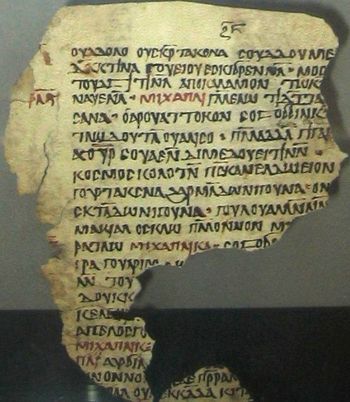Old Nubian language
2007 Schools Wikipedia Selection. Related subjects: Languages

Old Nubian is the name given to the written language used in medieval Nubia from the 8th to the 15th century AD. It is an ancient variety of the Nubian languages, which is still spoken in the area; in particular, it is probably ancestral to the modern-day Nobiin variety. It is preserved in at least a hundred pages of documents, mostly of a Christian religious nature, written using a modified form of the Coptic ( Greek) script; the best known is The Martyrdom of Saint Menas. It is the oldest written sub-Saharan African language apart from Meroitic and Ge'ez.
Writing
Old Nubian is written with an uncial variety of the Greek alphabet, extended with three Coptic letters — ϣ "sh", ϩ "h", and ϭ "j" — and three unique to Nubian: ⳡ "ny" and ⳣ "w", apparently derived from Meroitic; and ⳟ "ng", thought to be a ligature of two Greek gammas. Each letter could have a line drawn above it, when it was:
- a vowel which formed a syllable by itself, or was preceded by one of l, n, r, or j;
- a consonant with an i (sometimes unwritten) preceding it.
The sound /i/ could be written ε, ̄ ει, η;, ι, or υ; /u/ was normally written ου. In diphthongs, a dieresis was sometimes used over ι to indicate a semivowel y.
Geminate consonants were written double; long vowels were usually not distinguished from short ones. Tones were not marked.
Punctuation marks included a high dot •, sometimes substituted by a double backslash \\, used roughly like an English period or colon, a slash / used like a question mark, and a double slash // sometimes used to separate verses.
Grammar
Noun
Old Nubian has no gender, nor any articles. The noun consists of a stem to which grammatical case suffixes and postpositions are added; the main ones are:
- -l nominative, marking the subject: eg diabolos-il "the devil (subj.)"; iskit-l "the earth (subj.)".
- -n(a) genitive, marking the possessor: eg iart-na palkit-la "into the sea of thoughts".
- -k(a) "directive", marking the direct or indirect object: eg Mikhaili-ka "Michael (obj.), to Michael"
- -lo locative, meaning "at"
- -la inessive, meaning "in(to)"
- -do, meaning "on"
- -dal meaning "with"
The commonest plural is in -gu-; eg uru-gu-na "of kings", or gindette-gu-ka "thorns ( object)", becoming -agui- in the predicative. Rarer plurals include -rigu- (eg mug-rigu-ka "dogs (obj.)" (predicative -regui-) and -pigu-.
Pronoun
The basic pronouns are:
- ai- "I"
- ir- "you (singular)"
- tar- "he, she, it"
- er- "we (including you)"
- u- "we (excluding you)"
- ur- "you (plural)"
- ter- "they"
Demonstratives include in- "this", man- "that"; interrogatives include ngai- "who?", min- "what?", islo "where?", iskal "how?".
Verb
The verb has five main forms: present, two different preterites, future, and imperative. For each of these, there are subjunctive and indicative forms. It conjugates according to person, eg for doll- "wish" in the present tense:
- dollire "I wish"
- dollina "you (singular) wish", "he, she, it wishes"
- dolliro "we wish", "you (plural) wish"
- dollirana "they wish"
Example text
κτ̄κα γελγελο̄ςουανον ῑη̄ςουςι να⋊αν τρικα• δολλε πολγαρα πεςςνα• παπο ς̄κοελμ̄με εκ̄κα
Kitka gelgelosuannon Iisusi manyan trika• dolle polgara pessna• papo iskoelimme ikka.
Literally: "Rock and-when-they-rolled-away Jesus eye pair high raising he-said father I-thank you."
Translated: "And when they rolled away the rock, Jesus, raising his eyes high, said: Father, I thank you."